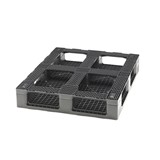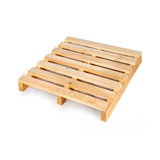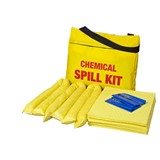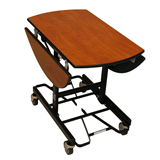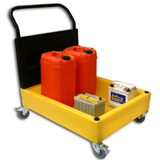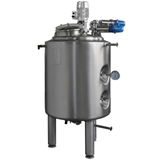Avoid spills, injuries and non-compliance. This expert guide shows you how to select bunded pallets, drum dollies, and IBC covers for safe, legal chemical storage in Australia.
Key takeaways
- Regulatory compliance is critical: The Australian Environmental Protection Authorities (EPA) and Safe Work Australia mandate spill containment to prevent environmental contamination and workplace hazards. Non-compliance can lead to fines exceeding $1.1 million (NSW EPA, 2023).
- Choose bunded pallets with sufficient sump capacity: Australian Standard AS 1940-2017 requires bund volume to be at least 110% of the largest container stored, ensuring effective spill capture and compliance.
- Select equipment based on mobility and volume: Bunded pallets provide secure, static storage with high sump capacity. Bunded trolleys enable mobile handling with spill protection during transport, while drum dollies facilitate safe movement of individual barrels.
- Drum and IBC covers protect and comply: These covers shield against weather, reduce spill risk from rainwater ingress, and meet Work Health and Safety (WHS) regulations.
- Material matters: UV-resistant polyethylene bunded pallets withstand harsh Australian conditions and resist most chemicals, ensuring long-term durability and safety.
- Australian case study: A chemical manufacturer reduced spill incidents by 70% and avoided costly EPA fines by upgrading to compliant bunded pallets, trolleys, and drum covers.
Introduction
Effective chemical spill containment is not just good practice in Australian workplaces — it’s a legal necessity. Managing spills protects workers, the environment, and your business from costly penalties. For industrial buyers and safety managers, selecting the right bunded pallets, bunded trolleys, spill pallets, IBC bunded pallets, and drum dollies is a vital step in meeting WHS and EPA compliance while maintaining operational efficiency.
This guide provides a comprehensive overview of spill control equipment tailored for Australian industrial environments. It helps you understand regulatory requirements, product differences, and practical considerations so you can choose the right equipment to secure your chemical storage and handling.
Why spill containment matters: Australian EPA regulations and WHS obligations
Chemical spills can lead to soil and water contamination, pose health risks, and cause significant financial losses. Australian environmental protection agencies, such as the NSW EPA and EPA Victoria, enforce strict regulations requiring businesses to prevent pollution by using bunded or spill containment systems.
- Environmental protection: The Protection of the Environment Operations Act (NSW) and similar legislation require businesses to contain spills and leaks effectively to avoid pollution.
- Work Health and Safety (WHS): Safe Work Australia mandates employers provide safe storage and handling for hazardous substances to reduce exposure and injury risks.
- Financial penalties: Failure to comply can lead to fines exceeding $1 million, legal liabilities, and expensive clean-up costs (NSW EPA, 2023).
- Insurance requirements: Many insurance policies require proof of spill containment measures to validate claims after incidents.
Compliance isn’t optional — it’s crucial for your business’s legal security and operational continuity.
When to choose a bunded pallet vs a bunded trolley vs a spill pallet vs an IBC bunded pallet vs a drum dolly
- Bunded pallets are designed for long-term, static storage of drums and containers. They feature high sump capacity to effectively contain spills and are chemically resistant, making them ideal for hazardous liquids. Use bunded pallets when you need a robust, stationary storage solution.
- Bunded trolleys combine spill containment with mobility, allowing safe transport of drums within your facility. They protect against spills during movement and improve ergonomics, making them perfect for daily handling of chemicals.
- Spill pallets offer economical, general-purpose spill containment for smaller volumes or less frequent use. They typically have lower sump capacity but are easy to deploy for various containers.
- IBC bunded pallets are specially designed to hold Intermediate Bulk Containers (IBCs), which store larger volumes of liquid. These pallets provide sufficient bunding volume and durability to manage the risks associated with IBC storage.
- Drum dollies focus on mobility, enabling the safe and ergonomic movement of individual drums. They reduce manual handling injuries and are best suited for transporting single barrels over short distances.
Choosing the right cover for drums and IBCs: weather protection vs spill prevention
Drum and IBC covers serve several vital purposes:
- Prevent rainwater ingress: Avoiding water accumulation inside containers reduces overflow risk and environmental contamination.
- Minimise evaporation and chemical exposure: Covers protect volatile or hazardous chemicals from sunlight and air, maintaining their integrity.
- Reduce spill risk: They help contain minor leaks and limit spill spread.
- Compliance: Australian WHS regulations often require hazardous chemicals to be stored covered or enclosed.
When selecting covers, prioritise:
- Material durability: UV-resistant, chemical-resistant polyethylene is ideal to withstand Australian outdoor conditions.
- Fit and sealing: Covers should fit securely to prevent water or debris ingress but allow easy removal.
- Ease of use: Quick application encourages consistent use.
- Compatibility: Ensure the cover fits the specific drum or IBC sizes used at your site.
Mobility vs capacity: drum dollies and bunded trolleys for daily handling
Handling chemicals safely isn’t just about containment — it’s also about efficient and ergonomic transport.
- Bunded trolleys provide spill protection while moving multiple drums or heavier containers, making daily handling safer and more productive. They prevent spills on the move and reduce physical strain.
- Drum dollies are ideal for transporting single drums safely in tight or short-distance areas. Their ergonomic design decreases manual handling injuries and speeds up operations.
Choose bunded trolleys when moving multiple drums or heavier loads. Opt for drum dollies for single drum transport in confined spaces.
Cost breakdown: what to expect when budgeting bunded gear
Understanding the true cost of bunded equipment helps you budget effectively and avoid surprises. Whether you're upgrading an entire chemical storage facility or simply adding mobile trolleys for day-to-day use, here's what to expect in terms of pricing and additional costs.
Typical price ranges in Australia
Prices vary based on capacity, construction, and compliance features. Here's what you’ll typically pay on the Australian market:
- Bunded pallets (standard 2- or 4-drum units): $200 – $900
- Larger IBC bunded pallets can cost $900 – $1,500+
- Bunded trolleys: $200 – $1,500+, depending on drum size and mobility features
- Drum dollies: $50 – $450, ideal for single drum handling
- Covers for drums and IBCs: $50 – $400, based on material quality and sealing
These estimates are based on listings from Australian safety equipment suppliers and marketplaces. Prices can fluctuate depending on volume orders, freight costs, and manufacturer.
Hidden costs to plan for
Beyond the upfront equipment cost, factor in:
- Shipping and freight – Bunded pallets and trolleys are bulky and may require tailgate delivery or pallet jack access. Regional deliveries add cost.
- Spill kit integration – Some sites integrate bunded gear with spill response stations, adding $150 – $500 depending on the kit type.
- Drainage and grates – Pallets with removable grates or drain plugs can improve usability but add to cost.
- Replacement parts – Over time, covers, wheels, and seals may need replacing.
Checklist: What to consider when buying bunded solutions
Before investing in bunded pallets, trolleys, or spill containment products, review these critical factors:
- Material and chemical compatibility:
- UV-resistant polyethylene is recommended for Australian outdoor use.
- Verify chemical resistance to acids, solvents, oils handled on-site.
- Check corrosion resistance if any metal parts are included.
- Sump volume capacity:
- Comply with AS 1940-2017 requirement of bund volume ≥110% of the largest container’s capacity.
- Plan for future storage increases — avoid undersized sump volumes.
- Durability and construction:
- Look for reinforced structures suitable for heavy loads.
- Anti-slip surfaces improve worker safety.
- Drain plugs ease cleaning and maintenance.
- Regulatory compliance:
- Confirm compliance with Australian standards and EPA guidelines.
- Request certification or compliance documentation from suppliers.
- Operational needs:
- Assess if mobility is required; choose trolleys or dollies accordingly.
- Consider indoor vs outdoor use to determine material and UV protection needs.
FAQs about bunded pallets and spill containment equipment
Q1: What is the required sump capacity for bunded pallets in Australia?
Australian Standard AS 1940-2017 recommends the bund volume be at least 110% of the largest container stored on the pallet, ensuring adequate containment in case of leaks.
Q2: Are bunded pallets mandatory under Australian law?
While not every workplace is legally required to use bunded pallets, effective spill containment is mandatory under WHS and environmental regulations to prevent contamination and workplace hazards.
Q3: How often should bunded pallets and trolleys be inspected?
Regular inspections at least quarterly are advised to check for cracks, sump damage, or chemical degradation, maintaining safety and compliance.
Q4: Can bunded pallets be used outdoors?
Yes, provided they are made from UV-stabilised materials designed to resist Australian sun and weather conditions.
Q5: How do drum and IBC covers improve safety?
They prevent rainwater ingress, reduce chemical evaporation, contain minor leaks, and help meet WHS compliance, lowering spill risks.
Conclusion
Choosing the right bunded pallets, bunded trolleys, drum dollies, IBC bunded pallets, and covers is essential for Australian businesses managing hazardous chemicals. By focusing on regulatory compliance, operational requirements, and product durability, you can prevent costly spills, protect your workforce and environment, and avoid legal penalties.
Investing in quality bundled solutions tailored to your chemical storage needs — with sufficient sump capacity, chemical compatibility, and mobility — will future-proof your operations. With the right equipment in place, your business remains safe, compliant, and efficient.




